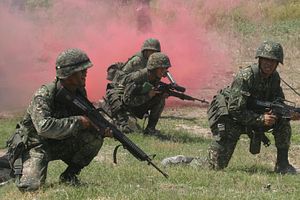For all the headlines that Philippine President Rodrigo Duterte generates – including on his “separation” from the United States – more often than not his rhetoric does not translate well into reality’(See: “The Limits of Duterte’s US-China Rebalance”).
That applies to U.S.-Philippine defense relations too. As I have noted previously, while Duterte had called for an end of all U.S.-Philippine military exercises, defense officials including Defense Secretary Delfin Lorenzana had indicated that Duterte in fact had little knowledge about the full extent of ties, even though his anti-Americanism is quite real and deeply-rooted (See: “Why the Philippines’ Rodrigo Duterte Hates America”).
The indications we have had so far is that certain aspects of U.S.-Philippine military ties may be downgraded, major agreements would remain in place (See: “How Much Will Duterte Wreck the US-Philippines Military Alliance?“). This includes the Enhanced Defense Cooperation Agreement (EDCA), a pact inked by both sides which would, among other things, give U.S. troops and equipment wide access to Philippine military bases on a rotational basis.
On Thursday this week, we got yet another confirmation that this was the case, even though there was not much in the way of specifics. During a January 26 press conference in Camp Aguinaldo, Lorenzana confirmed that the implementation of EDCA was going on as planned.
“The EDCA is still on,” Lorenzana said, prompting a series of follow up questions from Philippine journalists and a string of headlines thereafter.
Despite the sensationalism that followed, this was not news to close observers of the bilateral military relationship. Lorenzana was merely restating what he and others have indicated previously: that in spite of some changes, the Duterte government would still continue to adhere to all previous agreements between Washington and Manila, which include EDCA.
As Lorenzana subsequently clarified to reporters, the Pentagon has indicated that the United States would continue implementing its plans in “the EDCA-chosen camps” – meaning those that were already approved by both sides last March under the Benigno Aquino III government. As I have noted before, the first five locations that both sides had agreed to following their sixth annual Bilateral Security Dialogue (BSD) in Washington, D.C. were: Antonio Bautista Air Base; Basa Air Base, Fort Magsaysay; Lumbia Air Base; and Mactan-Benito Ebuen Air Base (See: “A Big Deal? US, Philippines Agree First Bases Under New Defense Pact”). So, again, all Lorenzana is saying is that things are proceeding as they were before.
But if all we’ve heard so far is that things are progressing as planned, what metrics should we use to assess if there are advances or setbacks being made? The devil here would lie very much in the details. We would have to look at things such as the equipment that the United States is placing in these bases as well as what kind of activities are going on between the two sides.
If you talk to those familiar with EDCA’s implementation, they would say that the range of activities run the gamut – from the prepositioning of equipment for humanitarian assistance and disaster relief to expanding training and exercises all the way to stationing aircraft and other defense equipment that can boost allied capabilities on the South China Sea. This is reflected in the five initial locations that were approved: Mactan-Benito Ebuen Air Base was the center for humanitarian assistance and disaster relief following Typhoon Haiyan, the deadliest Philippine typhoon on record which hit back in November 2013; Fort Magsaysay has been a key site for the largest annual U.S-Philippine exercise known as the Balikatan exercises; and Antonio Bautista Air Base is located on Palawan near the South China Sea.
Apart from the specifics of ongoing cooperation on already agreed sites, the approval of new locations further down the line would also be another indicator of progress. Both sides approved the initial sites with an understanding that given the controversial history of U.S. military presence in the Philippines in general as well as the scrutiny on EDCA in particular, the initial locations would be the lower-hanging fruit, with more sensitive locations approved further down the line that would allow for more robust cooperation. The degree to which that progression continues under Duterte remains to be seen.
An additional point to keep in mind when assessing progress is that in spite of all the noise on the Philippine side and the relative silence from Washington, there are factors on the U.S. side that will affect things too. For instance, funding for the construction of some facilities in the Philippines over the next few years, such as warehouses or runways – which, to be clear, would offer significant benefits for the Philippine military – would have to be allocated and approved by Congress. And the extent to which this gets scrutinized and tied into concerns by some U.S. lawmakers about democracy and human rights concerns in the Philippines will depend on what the Duterte administration does outside of the realm of military-to-military ties.
It is ultimately these more specific metrics, rather than general statements, that will ultimately tell us more about what kind of progress we are seeing or not seeing in the bilateral military relationship under Duterte.
































